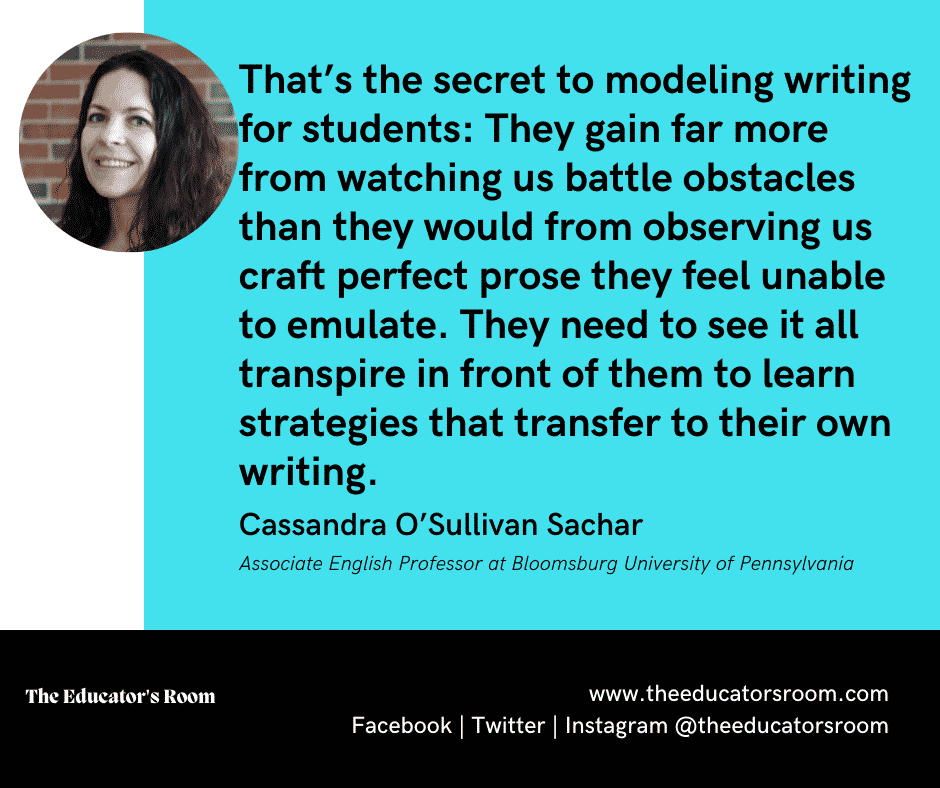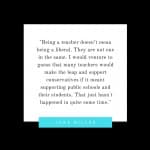by Cassandra O’Sullivan Sachar, Ed.D.

Cassandra O’Sullivan Sachar is an associate English professor at Bloomsburg University of Pennsylvania teaching first-year writing and secondary education English classes. She previously worked for fifteen years as an English teacher in Delaware public schools. She received her Doctorate of Education in Educational Leadership with a Literacy Specialization from the University of Delaware. In addition to writing for diverse educational publications, she enjoys writing fiction and is working toward an MFA in Creative Writing.
Students look to their teachers as experts in their fields; thus, if I teach writing, I must be an adept writer, one who writes effortlessly and flawlessly, avoiding common hurdles and smiling through every word that flows confidently from my fingertips into my keyboard and onto the page.
Yeah, right. I wish. I, too, have my moments, motivational and strategic, where I fumble to articulate ideas. Still, my students, many of whom consider themselves poor writers, sense a tremendous disconnect between themselves and me, their teacher. How can I communicate that writing does not magically spring forth from only naturally gifted writers? Why, by putting myself in their shoes and demonstrating that I, too, struggle at times but can overcome these challenges.
That’s the secret to modeling writing for students: They gain far more from watching us battle obstacles than they would from observing us craft perfect prose they feel unable to emulate. They need to see it all transpire in front of them to learn strategies that transfer to their own writing. Regarding this process, researcher Kerry P. Holmes writes about using modeling “to demystify the writing experience by exposing the teacher’s thoughts as he or she goes through the initial and often difficult stages of selecting a topic and selecting and organizing ideas… provid[ing] a way for students to imitate an I-can-do-it spirit when they hit the inevitable stumbling blocks of a writing assignment.”
This “demystification” process is crucial for promoting self-efficacy. Students necessitate hands-on demonstrations of prewriting activities like brainstorming and filling out graphic organizers in preparation for independent writing activities. The actual drafting process itself, however, is often excluded from the modeling experience, with teachers choosing to share already-created sample texts written by students, professional writers, and themselves. While these are also important for learning, they’re finished products. Students need to see the creation of the text projected on the screen in front of them, watching and learning by example as we type out words, delete others, repeat what we’ve written to check for clarity, and make adjustments. Our students must watch the writing come together, warts and all, misspellings, and awkward wording. By showing our own missteps and then using strategies to improve what we’ve written, we teach valuable lessons about how the writing process works.
Use Think-Alouds as Much as Possible
One common modeling approach is when the teacher talks about what occurs inside their head while writing, a “think-aloud” strategy: Since many teachers are already experts who no longer think cognitively about what transpires in their minds while reading and writing, it can be difficult to articulate to students how to proceed. But, when teachers model think-alouds, students who lack writing skills can adopt these strategies.
By talking students through the writing process, they see and hear how writing occurs. Before I model a piece of writing to students, I first teach them about “self-statements,” which can help with “problem definition, planning, self-evaluation, self-reinforcement, and coping.” These self-regulatory practices build in positive reinforcement to help keep the writer going while instilling reminders for the strategies they have been taught.
For example, when I recently modeled writing a persuasive paragraph, I demonstrated self-reinforcement: “I already made it through my first reason and support/explanation, so now I know I can do my second one. I feel good that I’m making progress in this paragraph.” In addition, a self-statement like this leads back to the paragraph parts they learned, therefore fortifying strategic support.
Let Them See You Struggle
A common fear for teachers is that students may judge them in a negative light if they share anything but a sparkling, finished piece of their own work. In a study of pre-service teachers, 109 out of the 192 interviewed rated themselves as poor writers, with 28% reporting they believed writing was a natural ability. However, now that we have entered the growth mindset age, it is up to us, as teachers and role models, to put aside these self-criticisms and focus on self-improvement instead. As education professor Elizabeth Bifuh-Ambe explains, educators must become “competent as writers and writing teachers in order to provide the kind of instruction and modeling that will help students develop into proficient writers.”If we’re not up to par, we should take steps to address these deficiencies.
As I work on modeling a draft with students observing my every word, I remind them that it’s okay if I’m not perfect since I’ll revise later. This takes some pressure off me and validates their own processes. Also, consider following up by showing the finished piece during the next lesson; let them perceive how your writing has improved, and they will have faith that their own can progress, as well. They need to see how we combat getting started, getting stuck, and getting confused to move on and end with a stronger piece.
Have Your Toolkit Ready
While students should witness you perspiring and fishtailing while working through the process, you still require an action plan. If you merely pretend to model and already know what you’ll write, it’s inauthentic. But, you should be prepared with your pre-writing already finished, your resources on writing requirements and strategies at hand, and your thesaurus function enabled before you start modeling the draft. Let your students see what they, too, can do to ready themselves for a productive writing session.
Be Mindful of Time
Even the most patient and scholarly students will lose focus if you take forever pondering the merits of several different adjectives rather than moving on to the next part of your draft. While self-evaluation is an important and necessary step of the first draft, there are times to tackle a problem right then and there, and there are other instances to save for later. For example, if I’m attempting to rebut an argument but realize that it fails to directly tackle the opposition, I’ll take the time to address it in front of my audience. After all, if I fail to show students how oppositions and rebuttals work together, they will likely grapple with this during independent writing. Therefore, I’ll go back to my graphic organizers for ideas and brainstorm more (thinking aloud) as I make the revision.
However, if the problem is a less crucial one like a lack of sentence variety, sometimes I’ll simply highlight a phrase or sentence as a reminder to come back to it later. I’ll move on to keep the class focused while acknowledging that there’s still work to be done. This is a strong lesson for students to avoid becoming bogged down in the minutiae.
Request that Students Copy Your Work as a Sample
To stay focused on the modeling process, it’s helpful for students to have something to do while I’m writing. This way, they’ll also have an additional sample text to which to refer as a resource when completing their own writing activity. Knowing that the modeled one will likely not be fabulous, I recommend additionally providing a polished piece as a sample text.
They write as I write, so they cross out and make changes along with me. While I’ve often heard students grumble when I make an edit or revision, it’s good for them to see the fluidity of writing. Revision doesn’t start when a first draft is completed; it’s built in along the way. Since I self-evaluate my work as I go, there are tweaks that I’ll make before completing the initial draft. I’ll self-evaluate and say, “I already used that word. Let me use the thesaurus and see if I can find a different one.” Students come away from the lesson not just with the experience of watching me write but with a messy-looking record of how I stumbled at times but ultimately triumphed through my writing task.
I’ve had tremendous success modeling writing with students of varying abilities and ages. Students have told me that they always figured writing was easy for me and that I didn’t make mistakes. Just because I teach writing doesn’t mean I have to pretend that any of this is true, and I’m more relatable as a member of their writing community when I share my own struggles. I utilize my own writing as an authentic example of how I may put in time and effort, but everything I write is still not gold; I show them drafts with revisions and notes from editors. By getting over the personal discomfort of self-exposure, my students have been able to put aside some of their own insecurities to take action and make improvements in both their confidence and achievement in writing.





